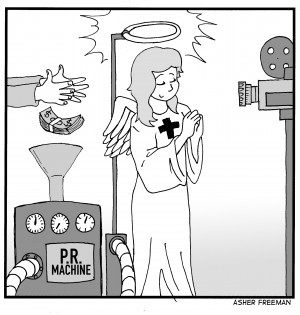 Hurricane Sandy devastated thousands of people two years ago. The American Red Cross, as in many other disasters, was one of the main responders. The organization had several official endorsements that assured people that it could and would help relieve the affected areas of the East Coast. Even President Barack Obama publicly endorsed the Red Cross, saying that the organization knew what it was doing.
Hurricane Sandy devastated thousands of people two years ago. The American Red Cross, as in many other disasters, was one of the main responders. The organization had several official endorsements that assured people that it could and would help relieve the affected areas of the East Coast. Even President Barack Obama publicly endorsed the Red Cross, saying that the organization knew what it was doing.
Why then, did NPR and ProPublica report last week that the Red Cross appeared more concerned with its appearance during the disaster than with actually helping the victims? These news outlets reported that the Red Cross wasted various materials and seemed to want to make its presence known for public relations reasons.
If this is true, which documents and witnesses affirm, then the American Red Cross has disappointed thousands of Americans.
For an organization that wants to help people, it should not be concerned with its image so much as ensuring it is helping to the best of its ability.
According to NPR, the organization struggled to meet the basic needs of victims in the first weeks after the storms. For any organization, it can be difficult to ensure its help is beneficial in every disaster situation. Even the Red Cross would have some struggle at some point.
But NPR quoted Gail McGovern, the president and CEO, who said, “I think that we are near flawless so far in this operation,” two weeks after the storm. Optimism is not and should not be uncommon in the aftermath of a storm. Believing recovery is possible is just one step to actually recovering. However, there is a difference between optimism and misinformation. The country followed the relief efforts after Sandy closely, and to tell Americans that everything is under control when it may not have been was wrong.
According to a “Lessons Learned” report from the Red Cross, there were several things that went wrong during the Sandy relief efforts. As with any organization, this report documents a meeting to examine what went wrong and what went right during an event. The Red Cross also included suggestions on how to fix the problems for future disasters, which is something NPR did not report.
One problem was that the Red Cross staff on site did not know the procedures to follow when it came to sex offenders. The offenders were dispersed all over the dorm, when they should have been allotted to a particular area. In addition, the report mentions failures to keep up with food distribution. There were problems tracking the food provided by volunteers. In one case, there was an entire trailer of food left to waste “that no one knew about until we got the bill.”
Then, many emergency response vehicles arrived on scene empty, instead of with life essential items such as snacks, water, etc. The Red Cross also pushed items into areas where they were not needed, mainly because the Red Cross was not aware of the actual need.
Some of the problems NPR cites are not actually a direct result of problems with the Red Cross. For example, the distribution of food was not efficient. The report states that the “state took too long on decision of kitchen locations,” which caused the loss of over three days of hot food deliveries. In this case, it appears to be the state’s fault. The Red Cross mentions the state several times in the report. It seems the Red Cross assumed the state would play a bigger role in coordinating the relief efforts. When the state did not, the Red Cross was left to figure out what needed doing on its own, which led to miscommunication and poor resource allotment.
Then, there are always considerations for first-time volunteers who may not have known every procedure. There was a surplus of volunteers, so many that the Red Cross did not know where and who they were or when they needed food or shelter. The report states that many volunteers just went home because they did not have food or a place to stay.
While there were many more issues the Red Cross raised on its performance during Sandy, there were just as many solutions the Red Cross proposed to solve its own problems. Some may say the Red Cross is experienced and should have known how to handle a disaster from the get-go. This is a valid argument. Much of what the Red Cross states as solutions are things that should have already been worked out. However, every disaster is different and not every plan will work for every relief effort.
At this point, it’s obvious the Red Cross made many errors in disaster relief. However, it seems the organization has examined what went wrong and should be prepared to avoid these mistakes in the future. Overall, the organization did help people in the disaster and continues to help in various locations all over the nation. In this case, the problems the Red Cross caused and endured were publicized. The Red Cross should take this opportunity to admit its failings, but also promote its solutions, assuring people that it has taken the time to implement the changes it generated.
The Red Cross is not a perfect organization. It will fail. However, it’s how the Red Cross moves forward from this criticism and issues that will define how people view the Red Cross in the future.



